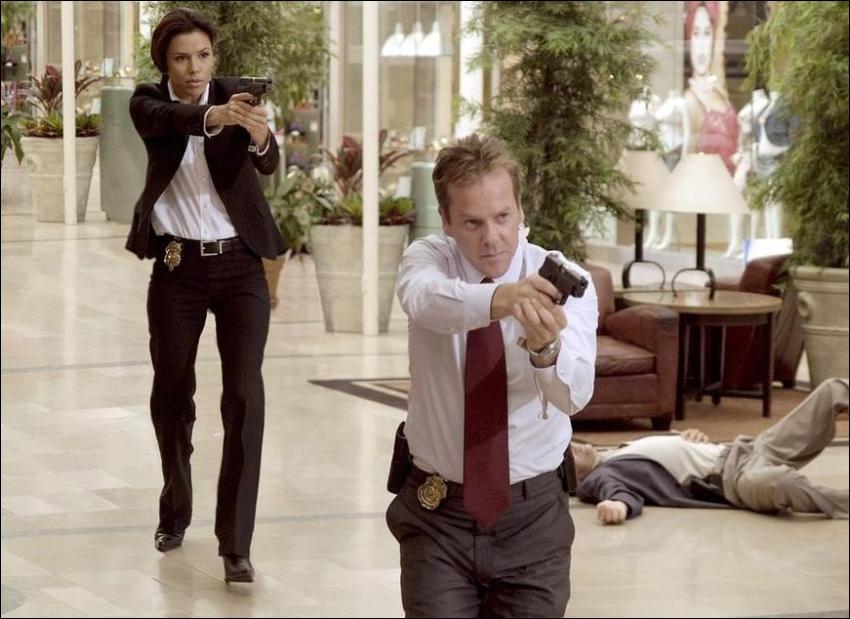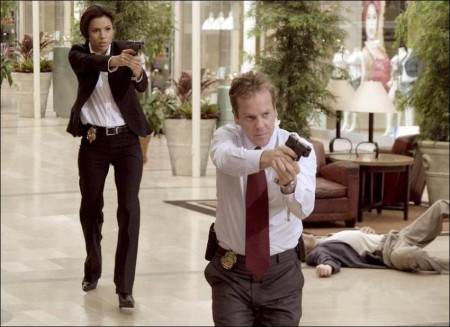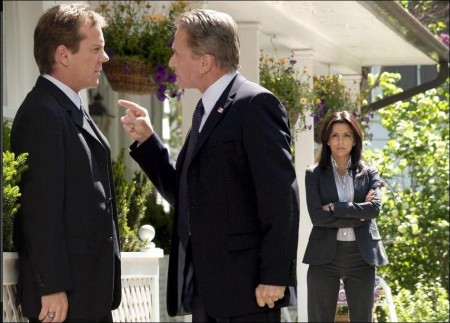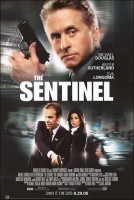Tagline: In 141 years, there’s never been a traitor in the Secret Service… Until Now.
A suspense film based on the novel by former Secret Service agent Gerald Petievich. Special Agent Pete Garrison (Douglas) suspects that the neo-Nazi Aryan Disciples have positioned one of their own in the White House, but his investigation is cut short by a blackmailer who knows of his affair with the First Lady Sarah Ballentine (Basinger) and tries to frame him for murder. Though he is officially relieved of his duties, Garrison doesn’t stop trying to prove his innocence and save the presiden’t life. He comes into a direct confrontation with his protege, hardheaded Agent Breckinridge (Sutherland).
Pete Garrison is a U.S. Secret Service agent who saved a president’s life by jumping in front of a hail of bullets, over twenty years ago. Well-liked and respected by his colleagues in the Secret Service, Garrison is a career agent who now heads the First Lady’s detail. He lives in a high-level, orderly world of hierarchical structure, plans, maps, motorcades, code names, lingo and procedures. It’s a universe that makes sense, until secrets begin to tear it apart.
Pete’s fellow agent and friend, Charlie Merriweather, hints at wanting to share critical and confidential information. Before that can happen, however, Merriweather is shot dead at his house in a crime that is made to look like a botched robbery.
The investigation falls to the Secret Service’s top investigative agent, David Breckinridge, a volatile combination of by-the-book and hothead, Garrison’s protégé, and, until recently one of Garrison’s best friends. Breckinridge follows the evidence and only the evidence and scrupulously tries to avoid working from his gut. That’s what being a great investigator requires. Garrison, as perhaps the greatest protective agent in the service, often has to work from gut, from pure instinct. In protective work that is often all you have.
Garrison’s and Breckinridge’s recent falling out was triggered by Breckinridge’s mistaken belief that Garrison was having an affair with Breckinridge’s now ex-wife. Jill Marin, a tough, sassy and ambitious young agent who just graduated second in her class at the Secret Service Academy, arrives for her first field posting. She has requested a work detail with Breckinridge because Garrison, while leading a field instruction exercise at the Academy told Jill that Breckinridge was the best investigator in the entire Service.
Together the trio begins to uncover what appears to be an inside job to assassinate the president – a traitor in the ranks of the Secret Service. It’s never happened in the institution’s 141-year history. Suspicion ultimately falls on Garrison, who’s going to find it extremely difficult to clear his name because someone is framing him. Whoever is framing Garrison knows he’s vulnerable because he’s devoting considerable effort to hiding a monumental secret. Suspected of being treasonous, Garrison goes on the run, pursued by Breckinridge and Marin – his own colleagues – as he tries to nail the real mole and save the president’s life.
About the Production
“The Sentinel is a political thriller about the agents assigned to protect the president and First Lady,” says Michael Douglas. “For the first time in its history, there is a mole in the Service plotting to kill the president. I play an agent assigned to protect the First Lady. It’s about my redemption. My character is a career officer who’s committed an act of indiscretion, and I find that intriguing. I don’t know many people who are all good or all evil. So there is moral ambiguity. I’m attracted to characters like Pete Garrison, who is flawed but tries to overcome his flaws in some way. Even Secret Service agents make mistakes.
“The Sentinel is unpredictable, topical and has a few twists and turns in it,” Douglas continues. “It’s fascinating to learn about the Secret Service’s inner workings and some of the technologies used by the Secret Service. I hope audiences will gain a little more understanding of what goes on behind the scenes: the number of death threats, the amount of research the USSS agents do. These are brave souls.”
As a producer, Douglas is always looking for interesting and provocative stories. “Finding good material sounds simple but it’s not,” says Douglas. “I’ve had my share of message movies but only because they worked as entertainment. I love acting, but the fact is that I don’t see that many pictures I’d like to do, so sometimes you have to develop them. I liked the idea behind The Sentinel because in an era of fear and paranoia, the notion of an unseen enemy is credible – that’s the film’s big ‘what if?'”
Furthur Films secured the rights to the novel The Sentinel by Gerald Petievich, before its publication. “We thought the book’s premise would make a thoughtful, compelling and classic-style political thriller,” says producer Marcy Drogin. “Every iconic institution has had its share of scandal, but the U.S. Secret Service is held to a higher standard. That was intriguing to us, to peel away the layers.
“Also,” Drogin continues, “it provided the quintessential Michael Douglas role as a flawed but sympathetic character.”
In order to present certain aspects of the Secret Service as realistically as possible, the film’s screenwriter and co-producer, George Nolfi, undertook extensive research. “From the beginning I wanted the story to be realistic,” Nolfi says. “I wondered: How is the president really protected? Where do the threats come from? What would truly put his life in danger, and how would the Secret Service react?”
As Nolfi honed the screenplay, Douglas and Drogin brought in Clark Johnson to direct. Johnson had previously directed a pilot about the Secret Service called “The Service,” which pointed to his interest in the topic. Johnson, also a respected actor, has worked in almost every area of the film business, including stunts, special effects, and camera. In addition, he is experienced with law enforcement action thrillers, ensemble pieces, multiple cameras, large set-ups and special effects. For The Sentinel, Johnson used this extensive background to depict the reality and grittiness of the Secret Service world.
Johnson worked closely with Douglas and Drogin to cast the picture. Once Douglas was on board, Kiefer Sutherland, Eva Longoria and Kim Basinger followed in the other three key roles. It was not Douglas’ first time working with Sutherland; Douglas had produced “Flatliners,” one of the movies that catapulted Sutherland into the ranks of exciting new film stars. “That was when I first met Kiefer and saw how talented he was. In The Sentinel, he brings tremendous credibility to his role,” says Douglas.
Sutherland responds with equal enthusiasm about Douglas. “If you look at Michael’s films, they’re Class A. I had the pleasure of working with him when I was very young, and he was so gracious and kind to me. I watched his films over the years and learned what makes him a phenomenal producer. There’s a sense of responsibility and dignity in all his films. I’ve watched his table-read, his notes, how he handles himself on set. It’s been an education and a pleasure, and I’m grateful for that.”
As the lead investigator in the film, Sutherland’s David Breckinridge sometimes lets his personal feelings interfere. “He has a past,” acknowledges Sutherland, “and our past often trips us up. Those elements start to break down what could be a perfect investigator.
“We as a society have an appreciation of any specialist in any field, where education and training have been taken to a certain level,” Sutherland continues. “I’ll never forget the Secret Service agent who moved to the left of President Reagan, closed his eyes and waited. He stayed in that position to take those hits. Would I have the courage or presence of mind to remember my training in that circumstance? That’s the first question I asked myself. We have to have an incredible amount of respect for Secret Service agents.”
Sutherland also was pleased to collaborate with on-screen partner Eva Longoria. “She has an incredible sense of focus,” he says. “The character she plays betrays her personality and that’s the mark of a great actor.”
Longoria’s Jill Marin was trained at the Academy by Michael Douglas’ character, Pete Garrison, and she joins the Sutherland character’s office upon graduation. Jill doesn’t initially know about the personal conflict between the two men. “[Screenwriter] George Nolfi beautifully weaves together their stories,” says Sutherland. “Jill’s history with Garrison reminds David Breckinridge of his connection to Garrison. This makes her question the direction of the investigation. It’s all about loyalties.”
Sutherland, like the others, enjoyed having an actor as a director in Clark Johnson. “There is a commonality there,” said Sutherland. “That’s undeniable. Clark has an innate sensitivity and that’s a two-way street. To know what it’s like to work in your shoes is a gift.”
Eva Longoria chose The Sentinel for her first big movie role because it is so different from her hit TV series “Desperate Housewives.” “It’s a triangle between Michael, Kiefer and me, but it’s not a love triangle,” says Longoria. “That’s why I chose this movie. It’s the opposite of Gabrielle [Solis, her TV character].”
Longoria plays the only woman on the team. “She’s an eager beaver,” says Longoria about agent Jill Marin. “She wants to learn, totally downplays her sexuality, has to prove herself twice as much as a man, and is determined to be the best she can be. She’s new but not complacent; she thinks outside the box. It’s not about the clothes, the hair and the make-up, the way it is for [“Desperate Housewives’] Gabrielle. Jill Marin is all about the work.”
Although Longoria is slightly built, that was not a liability. “The Secret Service is made up of aggressive, intelligent, fit, ambitious individuals with an air of confidence,” she says. “It’s not about size. Jill is definitely one of the boys.
“I felt comfortable amid all the testosterone because I’m a tomboy,” Longoria adds. “I grew up on a ranch and used to go target-shooting with my dad. I shot my first gun when I was six! I was the best shot.” Longoria found it an exciting journey. “I asked the Secret Service advisors a lot of questions. I have newfound respect to these people and what they do for our country.”
Martin Donovan, who plays Special Agent in Charge William Montrose, says, “It wasn’t until I read the script that I realized how much we take the Secret Service for granted. One of my goals was finding the humanity behind the image they present. They appear implacable, stoic, hyper-vigilant and intimidating, but they have a grace in their physicality. The detail leader of the Presidential Protective Division has to be able to hold his own at cocktail parties with world leaders. And our Secret Service advisors tell me they are inundated with questions at such events.”
Secrets of the Secret Service
In order to bring the interior world of the Secret Service to cinematic fruition, the producers brought in a retired Secret Service agent as an advisor. Gerald A. Cavis, a recently retired USSS agent and nationally recognized law enforcement expert, spent years protecting presidents and developing law enforcement and security techniques. In his career, Cavis, who lent his expertise to every aspect of the Secret Service activities and details portrayed in the movie, had direct responsibility for overall security at such events as the 2001 and 2004 presidential campaigns and inaugurals, the NATO 50th Anniversary Summit in Washington, D.C., and the visit of Pope John Paul II to St. Louis. He has been a primary consultant to other large events such as the G-8 Summit at Sea Island, Georgia, the presidential debates and the Athens Olympics.
Cavis has been a field agent, specializing in interrogation, the polygraph program, and undercover work. In D.C., he served on the elite Presidential Protective Division (PPD) from 1994 to 1997, during President Clinton’s term, rose to supervise one of four teams directly responsible for the president’s safety, and was also in charge of Clinton’s second inaugural.
Now a national security specialist and educator, Cavis brought a network of law enforcement’s most sought-after professionals, such as his colleague Kevin Billings, another former agent, who protected presidents and dignitaries for more than 20 years.
Cavis was impressed with the filmmakers’ – and the source material’s – intent to accurately portray the world of the Secret Service. “Gerald Petievich, the author of the book, was a former Secret Service agent himself,” says Cavis. “And [screenwriter] George Nolfi did an outstanding job. His level of knowledge and research to create the realism was almost scary.”
The screenplay is liberally sprinkled with bits of lingo. “George and Clark and I talked a lot about the dialogue,” said Cavis, “so the actors would talk like real agents.” The look of the government offices – how the radio console, desks and computers were set up – had to be as accurate as possible, although a few liberties were taken to accommodate camera movements and visual style. Garrison’s White House office, for instance, would be very modular and functional, with a lot of paperwork and supervisory documents for signing, while the desk of the agent in charge of the detail would be clean because he would have a staff to handle his paperwork.
In order to accomplish the forensics reports and threat letters, Cavis sat with the production design staff and guided them in the designs. He helped the costumers select shoes and boots: Secret Service agents wear tie shoes rather than slip-ons, “so they don’t come off when you take off running,” he explained. The fabrics were high-end, “not like an FBI agent in double-knit nylon,” says Cavis. He also helped to choose the right sunglasses, earpieces and sleeve microphones. In addition to props, costumes and the art department, Cavis and Billings advised on the motorcade cars and armored protection vehicles.
Weapons Training
Cavis and weapons specialist Charles Taylor taught Michael Douglas, Kiefer Sutherland and Eva Longoria to shoot real guns the way Secret Service agents actually do it. This tactical training, similar to some of what agents actually receive in the Academy, taught the actors gun safety, including handling, drawing and holding, plus range safety, range rules, aiming, firing, holstering, loading and reloading. The experts outfitted the actors with the same weapons – 9mm Sig-sauers, holsters, belts and rounds – as those used by agents, plus proper protective clothing, including ballistic vests, and eye and ear protection. “Kiefer does a lot of gun handling on the set of ’24,’ said Cavis, “but not with real guns. He found it very useful to learn how to find the right site picture that enables you to hit the target, and he shot very well. Michael had had some training as well and he also shot very well.”
After the live ammunition shooting, the actors learned how to approach, ride in, and exit a motorcade, which way they would turn, how to move and act as they surround the person they’re protecting, protocols on how to use their bodies as shields, how to protect themselves, and how to ID a suspicious person, all with a high degree of authenticity. They received instruction in the shift formations agents use while walking with the President or First Lady, such as the “Diamond” or the “Box” shape. The motorcade has a particular alignment and organization of vehicles. They practiced entering and exiting cars and buildings in the correct way, plus covering and evacuation procedures. All training and procedures were correlated to the particular script requirements and scene set-ups.
Eva Longoria was the best shot among the cast members. Cavis explains why. “She had no bad habits. She listens very well and was able to translate that into the correct posture, trigger-pull, site-picture alignment, and physical requirements for hitting the target.” Douglas, Sutherland and Longoria were required to do live fire shooting on an indoor range, with target practice at three yards, five yards, seven yards, 15 yards and 30 yards, both standing and kneeling, with time limits. They then shot from 30 yards, ran 15 yards, shot at another target, and then shot through an open doorway. All were scored and then debriefed. Longoria hit every one at 30 yards. Then they put the targets next to each other. “She was exceptional,” said Cavis. “In fact she would be recognized as a good shot even in the Secret Service. It was impressive.”
Michael Douglas adds his praise, “Eva’s a crack shot. I wasn’t ready for how good she was. They told us that she’s better than 90% of the police officers out there. She’s quite the athlete.”
All three stars gained new respect for what these agents do. It’s difficult to run, move and shoot at the same time. “Our stars have that cool and confident look,” says weapons specialist Charles Taylor. “They all exude it. But women are generally better shooters. They’re more still. They don’t have all that testosterone coursing through them. They just look through the site and not at the target and they hit it.”
The Look of The Sentinel
“The look of this movie is one of kinetic energy,” says director Clark Johnson. “That’s why we used many cameras and lots of moving shots.” Johnson and his director of photography, Gabriel Beristáin, previously collaborated on “S.W.A.T.,” in which they created spectacular depictions of Los Angeles. On The Sentinel, they merged the look of a big action thriller with the glamour of the White House and a very elite law enforcement organization. “So much happens within that world,” says Beristáin. “We wanted to give that world a visual style, a high beat, visual staccato.
“We worked out a progression to allow us to create and have our lighting and cameras react to the action. It’s a well-protected world at the beginning, with warm tones, elegant and classical camera movement. As the story becomes more ominous and nightmarish, our cameras and lighting respond to it, becoming cooler and more hectic in their movements. There are some overlaps of course. It’s not a mechanical, but a philosophical process. We are thinking in terms of audience emotion. We don’t want the audience to guess; we want to keep them wondering. Camera movement should not give away the story.”
The high shine and polish of the White House co-exists with a darker raw world as Garrison goes on the run. Johnson and Beristáin used a number of techniques, including traditional camera set-ups, video, Steadicam, hand-held, and sophisticated monitors showing the primary image as well as other glimpses into that world.
Examining a world rife with surveillance, the filmmakers provide a feeling of watching and of being watched, and of feeling that one is fully inside the world of the U.S. Secret Service. “We thought it would be interesting to see our film from the point of view of the audience,” says Beristáin. “The world we depict is not simple. The characters become paranoid and suspicious, even more aware of the people around them. The world around our characters is collapsing. It’s chaotic.
Beristáin was responsible for lighting two of the most beautiful women in the world: Kim Basinger and Eva Longoria. “Both have interesting character arcs,” says the cinematographer. “And I was lucky enough to have two women who look beautiful under any lighting circumstances.
“The First Lady’s world is crumbling in a way that could be disastrous. She had to go through a transition. We used much more than just glamorous lighting and her face responded to any lighting situation with dignity, grace and elegance. Eva’s beginnings in the movie are modest and humble, in a dark little Secret Service office where she meets Kiefer Sutherland’s character. As she grew as a character, we made the camera and the lighting on her different, making her a little more heroic. She took anything-direct lighting on her, low angles, not soft, no filtration-she looked absolutely marvelous. It was my privilege and my pleasure to work with both of them.” Beristáin comes from a European tradition of filming, where he says, “they celebrate the lighting you give them. Kim and Eva took it the same way the great European actors I used to work with did – and did it magnificently.”
Production designer Andrew McAlpine’s creations included an in-studio “Presidential Protective Division” (PPD) room, where the agents do their office work. It entailed an elaborate set-up of dozens of computer screens with streamed images, desks, work stations, protective intelligence and forensics reports, plus such details as mousepads, paperweights, chairs, binders, plaques, photos and flags.
Costume designer Ellen Mirojnick, who has worked on eight Michael Douglas pictures, decided to treat the Secret Service uniforms and suits in an elegant and sophisticated way, with garments sharply cut and sculpted to the body. Using dark, rich navies, no-pattern shirts, and an assortment of specific tonalities from blues to grays, she and her team created a look that added up to a uniform for the army they created. Like the other filmmakers, Mirojnick strove for realism – but made a slight exception for Eva Longoria. “She looks a little more beautiful than regulation allows,” laughs Mirojnick. “Our version is a little more stylish. The women wear pantsuits so they can run, but the fit is the key.”
These production notes provided by 20th Century Fox.
The Sentinel
Starring: Kiefer Sutherland, Michael Douglas, Kim Basinger, Eva Longoria, Kristin Lehman, Blair Brown
Directed by: Clark Johnson
Screenplay by: George Nolfi
Release Date: April 21st, 2006
Running Time: 105 minutes
MPAA Rating: PG-13 for some intense action violence and a scene of sensuality.
Studio: 20th Century Fox
Box Office Totals
Domestic: $36,280,697 (46.6%)
Foreign: $41,639,649 (53.4%)
Total: $77,920,346 (Worldwide)




